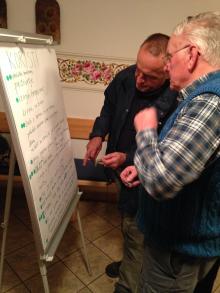Cultural landscapes caught between public good, private interests and politics
Principal Investigator at ZRC SAZU
Mimi Urbanc, PhDProject Team
David Bole, PhD, Matej Gabrovec, PhD, Primož Gašperič, PhD, Matjaž Geršič, PhD, Maruša Goluža, PhD, Drago Kladnik, PhD, Peter Kumer, Ph.D., Primož Pipan, PhD, Janez Nared, PhD, Drago Perko, PhD, Katarina Polajnar Horvat, PhD, Aleš Smrekar, PhD, Mateja Šmid Hribar, PhD, Jernej Tiran, PhD, Asst. Prof. Jani Kozina, PhD-
Project ID
J6-6854 (B)
-
Duration
1 October 2014–30 September 2017 -
Financial Source

Partners
Univerza v Novi Gorici
The project focuses on the rural cultural landscape and on agriculture, which plays a vital role in its formation. The project proceeds from the premise that landscape is a complex unit with three main stakeholders: 1) farmers/land owners; 2) other citizens, and 3) experts and decisionmakers, These groups of stakeholders are all quite different, but have in common a lack of communication amongst themselves and they have no knowledge of other two groups. Landscape is therefore a sphere with high conflict potential.
Main goal of the project:
To secure a sustainable and thoughtful development, which will take into consideration the complex structure, multilayered role and multifunctionality of the rural landscape, thereby satisfying all stakeholders, whose needs, expectations, demands and numerous processes guide the development, characteristics, functions and services of the landscape.
In line with the aim to identify and understand the functions of respective cultural landscape, we will conduct field work at three different pilot areas (Ljubljansko barje, Kras, Triglav National park). The following aspects will be taken into account during our research:
- landscape elements as parts of the cultural landscape
- landscape management and governance
- benefits of the landscape for local stakeholders and residents
- public and common good
- people's perception and attitutes toward cultural landscape
- interests and initiatives of local community related to landscape management and governance
The themes mentioned above will be discussed with local residents and other stakeholders during several workshops.

Workshop with local stakeholders in Čadrg (December 2015).
Research aims:
- to define landscape in the context of public goods, common goods and the public interest;
- to determine how and to what degree market conditions, values, attitudes and traditions on the one hand and policies and different measures on the other affect landscape management;
- to analyze the impacts of policies on the landscape and find out what kind of landscape the chosen measures promote;
- to unveil the role of the farmer not only as food and fiber producer but also as owner and a member of the local community;
- to unveil the role, expectations and needs of the citizens/general public that owns no land but is entitled to the use of public goods as offered by the landscape;
- to analyze the views and plans of policy makers, determine to what degree they are interested in landscape as a whole or whether they are primarily concerned with partial sectoral interests;
- to determine whether there are any differences among stakeholders, identify possible obstacles standing in the way of stakeholder cooperation and assess the possibilities for sustainable landscape management;
- to find out whether protection in the shape of landscape parks influences the altered patterns of landscape management on the one hand and the attitudes of citizens towards landscape on the other;
- to determine whether there are differences of opinion regarding landscape (in the light of public goods) between the general and the expert public.
Results:
- Šmid Hribar, M., Urbanc, M. 2016: The nexus between landscape elements and traditional practices for cultural landscape management. Biocultural diversity in Europe (Environmental history), 523-537. Springer International Publishing.
- International workshop on governance of Common-Pool Resources and their connections with Ecosystem Services.
- Involvement in the Partnership for preservation and popularization od dry stone wall construction.
- Šmid Hribar, M., Urbanc, M., Bole, D. 2015: Public And Common Goods in the Cultural Landscape. Geografski vestnik 87-2.
- Involvement in the International partnership for the Satoyama initiative- IPSI